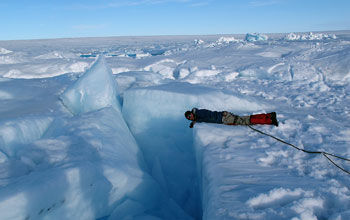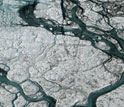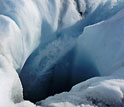News Release 13-129
NSF-Funded Research Sheds New Light on How Surface Water Lubricates the Bottom of the Greenland Ice Sheet
Study has important ramifications for understanding ice-mass loss and sea-level rise

Researcher Marco Tedesco peers into a crevasse on the Greenland ice sheet.
July 17, 2013
This material is available primarily for archival purposes. Telephone numbers or other contact information may be out of date; please see current contact information at media contacts.
"Supraglacial lakes"--bodies of water that collect on the surface of the Greenland ice sheet--lubricate the bottom of the ice when they drain, causing it to flow faster. Now, researchers have discovered that differences in how the lakes drain, how quickly or how slowly, can affect the speed and direction of glacial movement.
Researchers from the City College of New York (CCNY), the University of Cambridge in the United Kingdom and Los Alamos National Laboratory in New Mexico report the findings in the journal Environmental Research Letters.
"Knowledge of the draining mechanisms allows us to improve our understanding of how surface melting can impact sea-level rise, not only through the direct contribution of melt water from the surface, but also through the indirect contributions on the mass loss," according to Marco Tedesco, the principal investigator and lead author on the paper.
Tedesco, an associate professor in the CCNY's Department of Earth and Atmospheric Sciences, is currently on a temporary assignment as the program director for the National Science Foundation's polar cyber-infrastructure program. The research described in the paper was funded before he accepted the position at NSF.
Over the past decade, surface melting in Greenland has increased considerably.
Previous research already suggested that the water injected from the rapid draining of the supraglacial lakes controlled sliding of ice over the bed beneath it. However, there was no evidence of the impact of the slow draining mechanism, which the paper identified.
Tedesco and his colleagues documented two different drainage mechanisms, slow versus fast for supraglacial lakes. The findings are based on analysis of data collected in 2011 from five GPS stations the team installed around two supraglacial lakes in the Paakistoq region of West Greenland.
The smaller of the two lakes, Lake Half Moon, overflowed its banks and drained from the side to reach a moulin. It took approximately 45 hours to empty. The larger lake, Lake Ponting, drained through a crack in the ice beneath it and was voided in around two hours.
At first, a crack in the ice beneath the lake may be small, but it deepens as water enters it because the pressure of the water overcomes the compressive action of the ice, which is trying to close the crack, Tedesco explains. When the crack reaches the bed beneath the glacier, which could be 1,000 meters (3,280 feet) or more below the surface, the lake empties rapidly, like a bathtub after its plug is pulled.
Drainage from both lakes accelerated glacial movement. However, water from Lake Ponting caused the glacier to move faster and farther. While the slower drainage from Lake Half Moon caused the glacial pace to increase from baseline values of 90-100 meters (295-328 feet) per year to a maximum of around 420 meters (1,377 feet) a year, glacial movement in the area affected by Lake Ponting reached maximum velocities of 1,500--1,600 meters (4.920-5,249 feet) per year, nearly four times greater.
The drainage of the two lakes impacted the glacier's trajectory differently, as well. The emptying of Lake Half Moon via the moulin did not change the direction of glacial movement. However, when Lake Ponting drained, a slight southerly shift in the glacier's direction was detected.
Because the different draining mechanisms affect ice velocity, they could also affect the amount of ice lost through calving of glaciers, which results in icebergs, Tedesco points out. Because what happens on a glacier's surface impacts what is going on below, researchers are trying to look at glaciers as a system instead of independent components, he adds.
"The surface is like the skin of a tissue and the subglacial and englacial channels that develop because of the surface water act like arteries or veins that redistribute this water internally."
NSF supported the research along with NASA's cryosphere program, the Natural Environmental Research Council, the U.S. Department of Energy's earth systems modeling program, St. Catherine's College (Cambridge), the Scandinavian Studies Fund and the B.B. Roberts Fund.-NSF-
-
Water features on the surface of the Greenland ice sheet.
Credit and Larger Version -
Water flows from the surface to the bed of the Greenland ice sheet.
Credit and Larger Version
Media Contacts
Peter West, NSF, (703) 292-7530, email: pwest@nsf.gov
Ellis Simon, City College of New York, (212) 650-6460, email: esimon@ccny.cuny.edu
Principal Investigators
Marco Tedesco, NSF, (703) 292-7120, email: mtedesco@nsf.gov
The U.S. National Science Foundation propels the nation forward by advancing fundamental research in all fields of science and engineering. NSF supports research and people by providing facilities, instruments and funding to support their ingenuity and sustain the U.S. as a global leader in research and innovation. With a fiscal year 2023 budget of $9.5 billion, NSF funds reach all 50 states through grants to nearly 2,000 colleges, universities and institutions. Each year, NSF receives more than 40,000 competitive proposals and makes about 11,000 new awards. Those awards include support for cooperative research with industry, Arctic and Antarctic research and operations, and U.S. participation in international scientific efforts.
Connect with us online
NSF website: nsf.gov
NSF News: nsf.gov/news
For News Media: nsf.gov/news/newsroom
Statistics: nsf.gov/statistics/
Awards database: nsf.gov/awardsearch/
Follow us on social
Twitter: twitter.com/NSF
Facebook: facebook.com/US.NSF
Instagram: instagram.com/nsfgov


